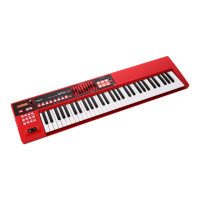36
Troubleshooting
If the XPS-10 does not function in the way you expect, rst check the following points. If this does not resolve the problem, consult your dealer or a nearby Roland
Service Station.
If any sort of message is being displayed on the screen during an operation, refer to “Error Messages” (p. 38).
Problems Concerning the Entire XPS-10
Problem Cause/Action
The power does not turn on
Make sure that the XPS-10’s AC adaptor is correctly connected to an AC outlet and to the rear panel power connector, and that the
adaptor itself and AC power cord are connected correctly (p. 8).
If a USB ash drive is connected, it may be that the USB ash drive is malfunctioning.
Disconnect the USB ash drive and turn on the power.
Issues Related to Sound
Problem Cause/Action
There is no sound
Is the power for connected amps and speakers turned on?
Could you have lowered the volume of your connected equipment?
Is the [VOLUME] knob turned all the way down?
Have connections been made correctly?
Can you hear sound through headphones?
If there is sound in the headphones, it is possible that the connection cables are broken, or that your amp/mixer has malfunctioned.
Check your cables and amp/mixer system once again.
If you do not hear sound when you play the keyboard, check whether the Local Switch is turned OFF.
Make sure that the Local Switch setting is turned on (p. 32).
Could the level of the patch be too low?
Check the level setting.
The Part level settings may be too low.
Check the level of each part (p. 25).
Are the Eect settings correct?
Check the Eect settings ON or OFF (p. 26).
Could the volume have been lowered by a MIDI message (volume message or expression message) received from the computer or by
operating the pedal?
Could the LEVEL sliders of the SOUND MODIFY section be lowered?
A specic Part does not sound
Has the volume level of the part been lowered?
Check the level of each part (p. 25).
Could the LEVEL sliders of the SOUND MODIFY section be lowered?
Could the keyboard switch be o?
Turn the keyboard switch on.
Specic pitch ranges do not
sound
Has a restricted range of notes been set?
If a specic range of notes does not sound, check the Key Range settings for the Performance Part.
Refer to p. 25, and check the key range of the part.
Pitch does not change in specic
key regions
For an imported sample, all notes more than two octaves above the original key are sounded at the pitch two octaves above. The
sample cannot sound at pitches higher than this.
The sound is distorted
Is an eect which distorts the sound being applied?
If the sound for a specic patch or part is distorted, lower the volume level on that part.
If all sounds are distorted, use the [VOLUME] knob to lower the volume level.
Could the Output Gain be excessively high?
Check the system setting “SOUND” (p. 31).
Pitch is incorrect
Is the tuning of the XPS-10 incorrect?
Check the “Master Tune” setting (p. 31).
Has the pitch been changed by pedal operations or by Pitch Bend messages received from a computer?
The sound is interrupted
Sounds will be interrupted if more than 128 voices are used simultaneously.
Reduce the number of Patches that you are using.
When I play the keyboard, notes
do not stop
Is the pedal polarity of the Hold Pedal reversed?
Check the “PEDAL” “Polarity” parameter setting (p. 32).
The sound cuts o when I switch
patch
Although you can apply a wide variety of multi-eects with the XPS-10’s multi-eects, switching the patch also switches the type of
multi-eects used.
In this case, an inconsistency occurs between the current sound and the type of multi-eect, causing unexpected sound, or making it
appear that the sound is no longer sounding.
Even when I set the Pan for a
patch completely to one side,
sound still comes from the other
channel
The XPS-10’s internal eects are in stereo, so if you have eects applied to a tone, even if the Pan is set all the way to one side, you will
still be able to hear sounds of the eect component from the other channel.
The notes sound strange in the
upper registers of the keyboard
Sometimes when playing the keys in the upper part of the XPS-10’s keyboard, the sound may stop, or the pitch may stop rising; or
with certain keys, there may be intermittent noise. This occurs mainly when the XPS-10’s upper pitch limit is exceeded, so this issue
doesn’t arise in the ranges normally used. But, in any case, it does not indicate a malfunction.
Although the same tone is
selected, it sounds dierent when
I listen to it in the Performance
In Performance mode, the parameters of each part of the performance can apply further modication to parameters such as pan,
octave, and lter, relative to the settings specied by the patch.
Thus, patches in a Performance may sound dierent than they do when heard in patch mode.
Additionally, although a patch may comprise sounds created with the use of the multi-eects, the multi-eects used in the
Performance may dier from the multi-eects selected by the patch. Check the multi-eect settings of the performance. Also do the
same for the Chorus and Reverb settings.

